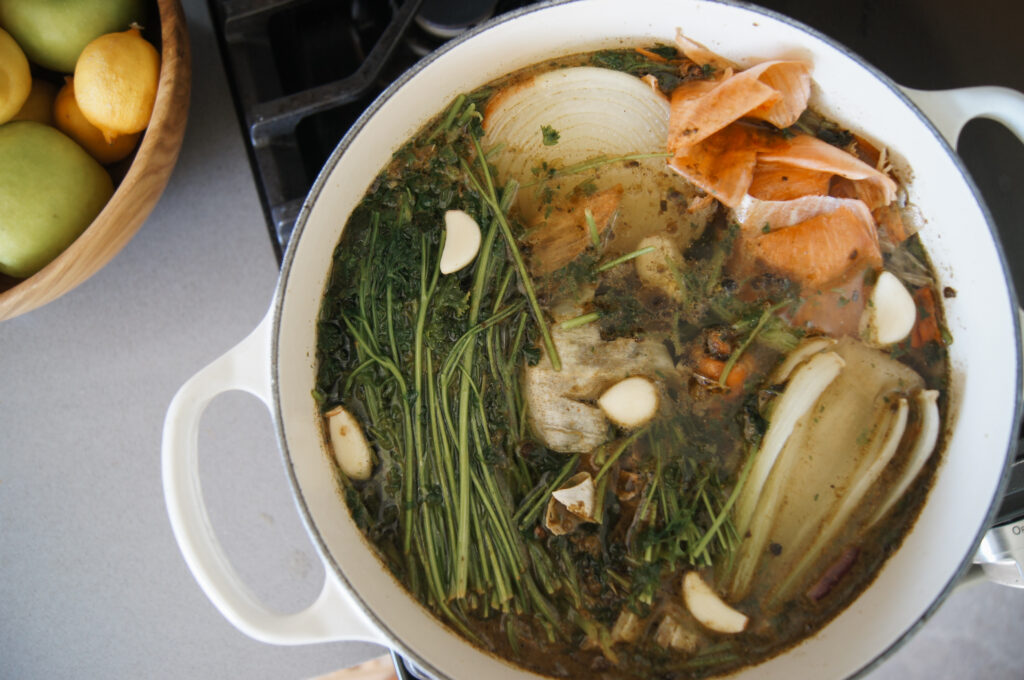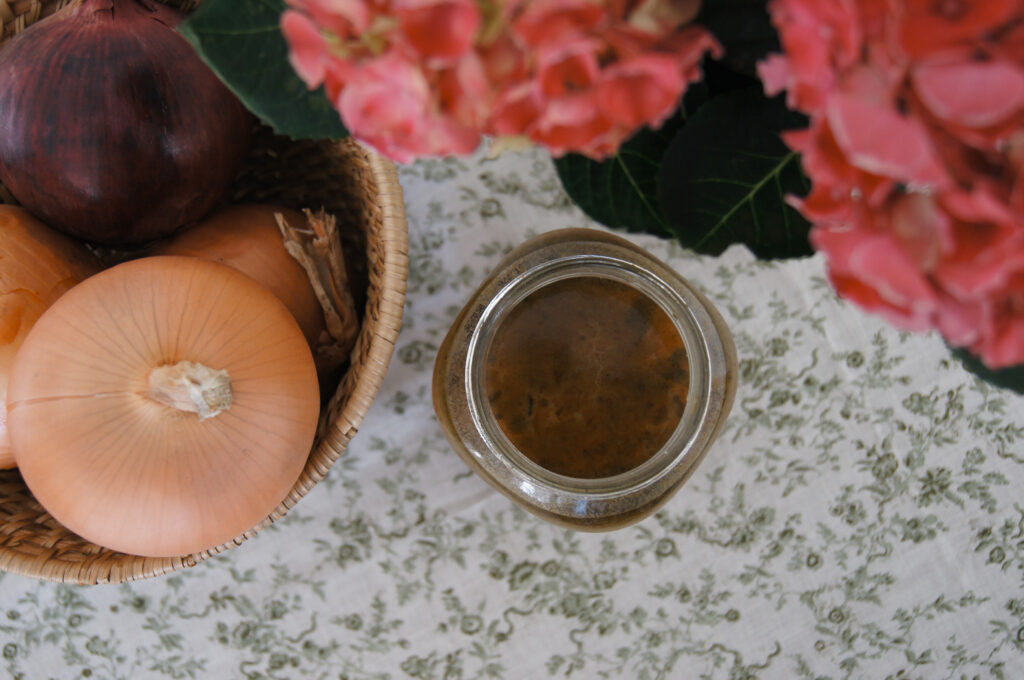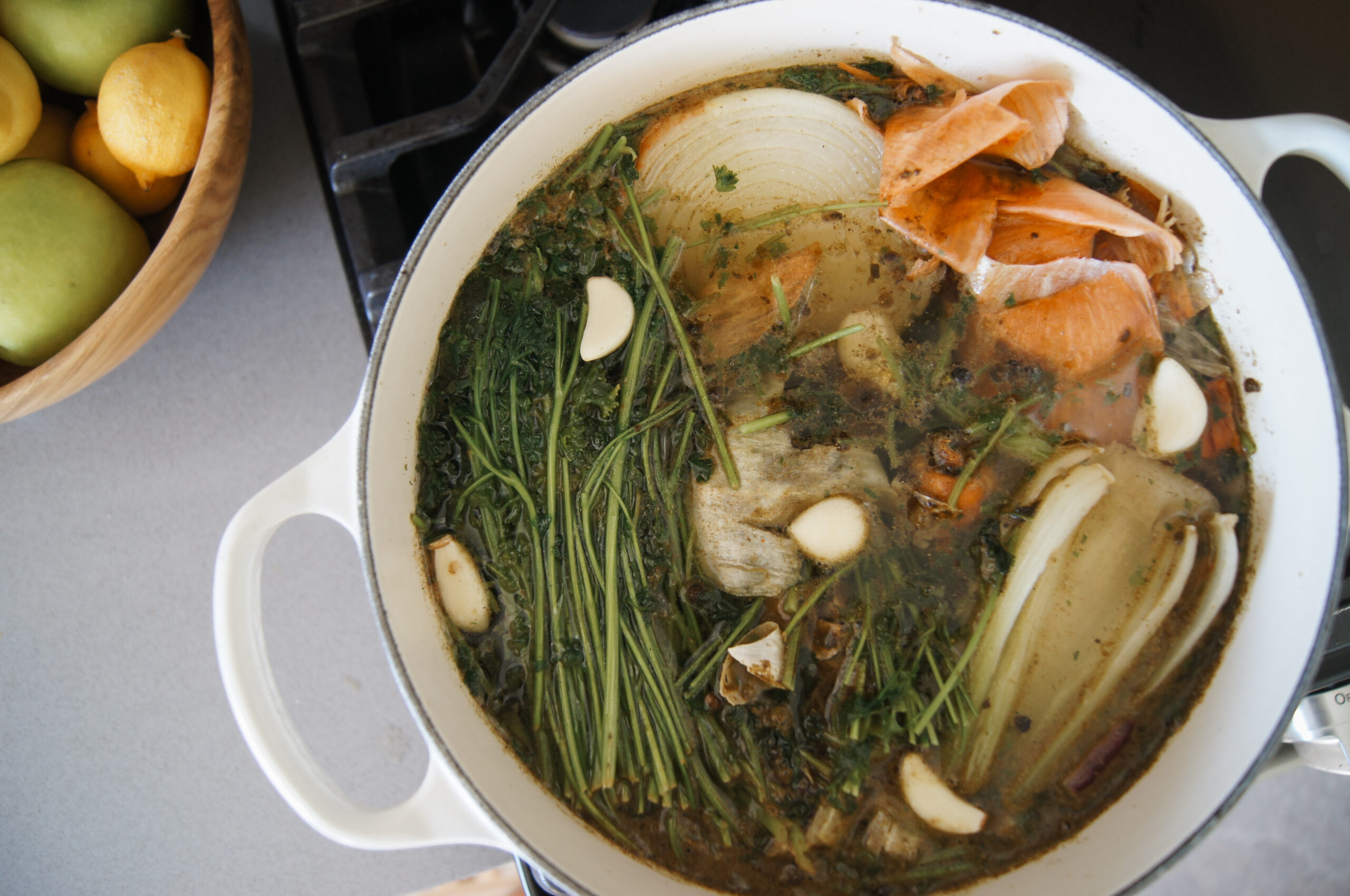A simple and sustainable way to reduce kitchen waste—and build flavor from ingredients you already have in your kitchen.
As someone who cooks most meals at home, I’ve become deeply aware of how much kitchen waste can build up—even in a real food kitchen. Learning how to make homemade vegetable stock from scraps was a turning point in how I approached sustainability in our home. On a trip to England, I saw something that stuck with me: a menu section labeled “Zero Heroes.” It featured recipes made entirely from food scraps. It inspired me to take an intentional look at how we could reduce food waste at home. I started with something simple: homemade stock made from vegetable scraps.
This zero-waste vegetable stock recipe is designed to use what you already have. As you prep meals during the week, save the vegetable scraps—onion ends, herb stems, carrot peels. Instead of tossing them out, simply store them in the freezer! Once your bag is full, you’re ready to make a nourishing batch of stock.

Here’s what I typically save:
- Onion ends and peels (yellow, white, or red)
- Garlic peels and ends
- Celery tops and inner stalks
- Carrot peels and ends
- Leek greens
- Herb stems (parsley, thyme, cilantro)
- Mushroom stems
How to Store Vegetable Scraps
Throughout the week, I collect scraps in a half-gallon Stasher Bag in the freezer, but you can also use any freezer-safe container you have on hand.. By the time it’s full, I know it’s time to make a batch of homemade vegetable broth.
How to Make Vegetable Stock at Home
Once your bag is full, making the stock is as simple as simmering and straining.
Ingredients:
- about 4 cups of frozen vegetable scraps, including scraps from 1-2 onions and 3-4 stalks celery
- parsley (fresh or frozen)
- 4-6 garlic cloves
- drizzle extra virgin olive oil
- 1 tbsp. black peppercorns
- salt to taste
- enough water to cover vegetables in pan
Instructions:
- Add your frozen veggie scraps to a large stockpot.
- Cover with water and add herbs and spices.
- Bring to a boil, then reduce to a gentle simmer.
- Simmer uncovered for about an hour.
- Strain the broth through a fine mesh sieve into jars or containers.
- Store in the fridge for up to 5 days, or freeze for longer storage.
That’s it—homemade vegetable stock from ingredients you were already using.
Optional: Turn It Into Bone Broth
If you’d like to add extra nutrients to your stock, try adding chicken or beef bones to the pot. Simmering the bones for several hours releases collagen, minerals, and amino acids—creating a deeply nourishing bone broth.
Bone broth can support:
- Skin, hair, and nail health
- Gut lining and digestion
- Joint and bone health
- Immune function
A tip from the Elmsgrove Lane kitchen: If adding bones, you may need to extend simmering time!
Ways to Use Homemade Vegetable Stock
This zero-waste vegetable stock is endlessly versatile and adds depth to all kinds of dishes. Here are a few ways we use it:
- As a base for soups and stews
- In Sunday roasts or braised dishes
- For cooking grains like quinoa, rice, or buckwheat groats
- In risottos (like our favorite Spring Vegetable Risotto) or hearty sauces

Homemade Vegetable Stock from Scraps: A Small Habit with a Big Impact
Choosing to make homemade vegetable stock from scraps is a small, nourishing habit that reduces waste, stretches your grocery budget, and brings new purpose to the parts of vegetables we often overlook.
It’s one of those simple kitchen routines that adds up over time—both in flavor and in the way it gently shifts how we think about sustainability. I hope it becomes a favorite in your kitchen, too.
Have you tried making stock from scraps? Let me know how you use yours, or tag me with your favorite variations. I love seeing what you create.
PrintHomemade Vegetable Stock from Scraps
This homemade vegetable stock is a sustainable, easy recipe that can add extra flavor to soups and stews. Save your veggie scraps throughout the week and you will have everything you need to make a low-cost, high-flavor kitchen staple!
For extra flavor, try roasted your vegetables before adding them to the stock! If you are in a pinch, just add your frozen veggie scraps directly to the pot to boil.
- Prep Time: 10 minutes
- Cook Time: 1 hour
- Total Time: 1 hour 10 minutes
Ingredients
This recipe is very loose, and any veggie scraps that you have on hand will make a delicious vegetable stock. Some of my favorite veggies scraps to use include shallot, leeks, and carrots.
- about 4 cups of frozen vegetable scraps, including scraps from 1-2 onions and 3-4 stalks celery
- parsley (fresh or frozen)
- 4–6 garlic cloves
- drizzle Olive Oil
- 1 tbsp. black peppercorns
- salt to taste
- enough water to cover vegetables in pan
Kitchen Tools You’ll Need
- large pot (I recommend Le Creuset)
- strainer
- mason jars for storage
Instructions
- Add all ingredients to large pot.
- Cover the vegetable scraps with water, leaving room in the pan for water to boil without overflowing.
- Bring the water and vegetable scraps to a boil on the stove.
- Reduce heat and simmer (uncovered) for about one hour).
- Remove from heat and let the vegetable stock cool a bit.
- Strain into mason jars for storage and freeze extra portions as needed.
Notes
Depending on the size of your pot, you may require more or less water or vegetables.
Make sure you have a strainer and mason jars on hand for storage! I recommend freezing any portions that won’t be used within about a week.
→
JOIN THE LIST
Subscribe to Today's Harvest by Elmsgrove Lane on Substack.

